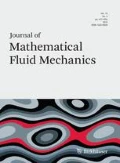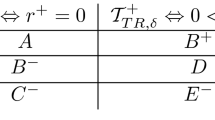Abstract
The boundary conditions prescribing the constant traction or the so-called do-nothing conditions are frequently taken on artificial boundaries in the numerical simulations of steady flow of incompressible fluids, despite the fact that they do not facilitate a well-posed problem, not allowing to establish the standard energy estimates. In a pursuit to understand better the possible consequences of using these conditions, we present a particular set of examples of flow problems, where we find none or two analytical or numerical solutions. Namely, we consider problems where the flow connects two such artificial boundaries. In the simple case of the isotropic radial flows where both steady and unsteady analytical solutions are derived easily, we demonstrate that while for some (large) boundary data all unsteady solutions blow up in finite time, for other data (including small or trivial) the unsteady flows either converge asymptotically to one of two steady solutions, or blow up in finite time, depending on the initial state. We then document the very same behavior of the numerical solutions for planar flow in a diverging channel. Finally, we provide an illustrative example of two steady numerical solutions to the flow in a three-dimensional bifurcating tube, where the inflow velocity is prescribed at the inlet, while the two outlets are treated by the do-nothing boundary condition.





Similar content being viewed by others
Notes
By the course of history, the label do-nothing usually refers to the condition (5) with \(\hat{\pmb {b}}=\pmb {0}\), but not to the zero traction \(\pmb {b}=\pmb {0}\) in (3). The term is not related to the underlying physics in any way. The label originates from the mere fact that the boundary term \((\hat{\pmb {b}},\pmb {w})_{\partial \Omega }\) is absent in the weak formulation (6). Therefore, we do not consider it convenient to use the term do-nothing for the condition (5) with general \(\hat{\pmb {b}}\).
We only take \(L^2\)-estimates of the boundary integrals, for simplicity.
Here we only follow the main idea and leave the details on how the results are formulated to the reader. For instance, the referred results are not stated for general \(\tilde{\pmb {b}}=\tilde{\pmb {b}}(\pmb {x})\), but rather for the particular choice \(\hat{\pmb {b}}=P_i\pmb {n}\).
One can experiment with more artificial boundaries as well, see Sect. 3.6.
In unidirectional simple flows, such as the flows in channels or pipes, the value \(P_i\), both whether given as the normal traction or full-gradient-traction, would correspond to the resulting pressure. It is then natural to call the difference \(P_1-P_2\) the pressure drop and to speak about pressure drop problems. However, it is worth noting that in non-unidirectional flows, such as the radial flows, the data \(P_i\) do not coincide with the resulting pressure. For the sake of brevity, let us denominate \(P_1-P_2\) as \(P_i\)–drop, in this paper.
By the phrase \(P_i\)–drop we avoid using the more common, but in our setting confusing, phrase pressure drop. See the footnote in Sect. 1.3.
See Sect. 3.7 for a few remarks.
Note that \(\pmb {e}_r = \frac{1}{r}(x,y) = -\pmb {n}\) on \(\Gamma _1\) while \(\pmb {e}_r = \pmb {n}\) on \(\Gamma _2\), and that the definition of \(Q_{\mathrm {num}}\) is independent on whether \(i=1\) or 2, due to \({{\,\mathrm{div}\,}}\pmb {u}=0\). For the isotropic radial flow presented in Sect. 2, where \(\pmb {u}=Q\tfrac{1}{r}\pmb {e}_r\), there is \(Q_{\mathrm {num}}=Q\).
Note that the unsteady solution would blow up in this setting (using the initial guess as the initial condition), as described later.
Or four, actually: the non-radial solutions appear in two variants symmetric around the axis \(x=y\).
Values of \(P_1-P_2\) close to \(P_{\mathrm {crit}}\) from both sides were tested as well.
The quantities we work with can be considered as non-dimensional here, the viscosity thus represents a reciprocal of Reynolds number. Note that Reynolds number \(\mathrm {Re}=50\) is related to the characteristic length equal to the diameter of the larger outlet, or to the distance of the centers of the two outlets, and to the characteristic velocity equal to the peak velocity at the inlet. Note that the peak backflow velocity of the second solution reaches five times more, which would then correspond to \(\mathrm {Re}=250\).
References
Galdi, G.P.: Mathematical Problems in Classical and Non-Newtonian Fluid Mechanics. In: Galdi, G.P., Rannacher, R., Robertson, A.M., Turek, S. (eds.) Hemodynamical Flows: Modeling. Analysis and Simulation, pp. 121–274. Birkhäuser Verlag, Berlin, Oberwolfach Seminars edition (2008)
Rannacher, R.: Methods for Numerical Flow Simulation. In: Galdi, G.P., Rannacher, R., Robertson, A.M., Turek, S. (eds.) Hemodynamical Flows: Modeling. Analysis and Simulation, pp. 275–332. Birkhäuser Verlag, Berlin, Oberwolfach Seminars edition (2008)
Heywood, J.G., Rannacher, R., Turek, S.: Artificial boundaries and flux and pressure conditions for the incompressible Navier–Stokes equations. Int. J. Numer. Meth. Fluids 22(5), 325–352 (1996)
Rannacher, R.: A short course on numerical simulation of viscous flow: discretization, optimization and stability analysis. Discrete Contin. Dyn. Syst. Ser. S 5(6), 1147–1194 (2012). https://doi.org/10.3934/dcdss.2012.5.1147. ISSN 19371632
Braack, M., Mucha, P.B.: Directional do-nothing condition for the Navier–Stokes equations. J. Comput. Math. 32(5), 507–521 (2014). https://doi.org/10.4208/jcm.1405-m4347
Bothe, D., Köhne, M., Prüss, J.: On a class of energy preserving boundary conditions for incompressible newtonian flows. SIAM J. Math. Anal. 45(6), 3768–3822 (2013). https://doi.org/10.1137/120870670
Bertoglio, C., Caiazzo, A., Bazilevs, Y., Braack, M., Esmaily, M., Gravemeier, V., Marsden, A.L.O., Vignon-Clementel, I.E., Wall, W.A.: Int. J. Numer. Methods Biomed. Eng. (2018). https://doi.org/10.1002/cnm.2918
Bruneau, C.-H., Fabrie, P.: New efficient boundary conditions for incompressible Navier–Stokes equations: a well-posedness result. Math. Model. Numer. Anal. 30(7), 815–840 (1996)
Lanzendörfer, M., Stebel, J.: On pressure boundary conditions for steady flows of incompressible fluids with pressure and shear rate dependent viscosities. Appl. Math. 56(3), 265–285 (2011). https://doi.org/10.1007/s10492-011-0016-1
Neustupa, T.: A steady flow through a plane cascade of profiles with an arbitrarily large inflow–the mathematical model, existence of a weak solution. Appl. Math. Comput. 272, 687–691 (2016). https://doi.org/10.1016/j.amc.2015.05.066
Lanzendörfer, M., Málek, J., Rajagopal, K.R.: Numerical simulations of an incompressible piezoviscous fluid flowing in a plane slider bearing. Meccanica 53(1–2), 209–228 (2018). https://doi.org/10.1007/s11012-017-0731-0
Alnæs, M.S., Blechta, J., Hake, J., Johansson, A., Kehlet, B., Logg, A., Richardson, Ch., Ring, J., Rognes, M.E., Wells, G.N.: The FEniCS project version 15. Arch. Numer. Softw. (2015). https://doi.org/10.11588/ans.2015.100.20553
Logg, A., Mardal, K.-A., Wells, G.N., et al.: Automated Solution of Differential Equations by the Finite Element Method. Springer, Berlin (2012)
Logg, A., Wells, G.N.: DOLFIN: automated finite element computing. ACM Trans. Math. Softw. (2010). https://doi.org/10.1145/1731022.1731030
Gresho, P .M., Sani, R .L.: Incompressible Flow and the Finite Element Method: Advection Diffusion and Isothermal Laminar Flow. Wiley, New York (1998)
Brezi, F., Fortin, M.: Mixed and hybrid finite element methods. In: Springer Series on Computational Mathematics, 15. Springer (1991)
Author information
Authors and Affiliations
Corresponding author
Ethics declarations
Conflict of interest
The authors declare that they have no conflict of interest.
Additional information
Communicated by S. Turek.
Publisher's Note
Springer Nature remains neutral with regard to jurisdictional claims in published maps and institutional affiliations.
Support to ML was provided by the project CzechGeo/EPOS-Sci co-funded by the EU Operational Programme “Research, Development and Education”. JH was supported by the Czech Science Foundation project GAČR 17-01747S.
Rights and permissions
About this article
Cite this article
Lanzendörfer, M., Hron, J. On Multiple Solutions to the Steady Flow of Incompressible Fluids Subject to Do-nothing or Constant Traction Boundary Conditions on Artificial Boundaries. J. Math. Fluid Mech. 22, 11 (2020). https://doi.org/10.1007/s00021-019-0472-z
Accepted:
Published:
DOI: https://doi.org/10.1007/s00021-019-0472-z
Keywords
- Navier–Stokes equations
- Boundary conditions
- Do-nothing
- Traction
- Existence
- Uniqueness
- Stability
- Finite element approximation




